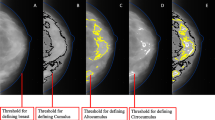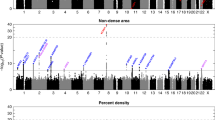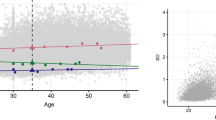Abstract
To understand the role of mammographic density on breast cancer risk, it is important to take into account body mass index (BMI). As with age, BMI is negatively confounded with mammographic density, and a previous US twin study found that the covariance structure of mammographic density depended on the extent to which pairs differ in BMI. Using a computerised thresholding technique, we measured mammographic dense area for 571 monozygous (MZ) and 380 dizygous (DZ) twin pairs aged 40–70 years from Australia and North America. After adjusting for age and BMI, we calculated estimates of variance, covariance, correlation and, under the assumptions of the classic twin model, additive genetic (A), common environment (C) and person-specific environmental (E) components of variance. Analyses were conducted both within and across categories of within-pair differences in BMI, under a bivariate normal model using the software FISHER. The variance, MZ and DZ correlations, and the differences between MZ and DZ correlations and covariances were not constant across absolute within-pair differences in BMI (for the DZ correlation, P = 0.04, all other P < 0.001). No model involving a combination of one or more of A, C and E gave an acceptable fit. The interpretation of these observations is not straightforward. They, and other data, challenge the assumptions of the classic twin model for mammographic density and suggest that an insightful test of those assumptions can be made by testing the stability of correlations, covariances and variance components across absolute within-pair differences in potential mediators.


Similar content being viewed by others
References
Boyd NF, Martin LJ, Yaffe M, Minkin S (2009) Mammographic density. Breast Cancer Res 11(Suppl 3):S4
Boyd NF, Lockwood GA, Byng JW, Tritchler DL, Yaffe MJ (1998) Mammographic densities and breast cancer risk. Cancer Epidemiol Biomarkers Prev 7:1113–1144
Boyd NF, Lockwood GA, Byng JW, Little LE, Yaffe MJ, Tritchler DL (1998) The relationship of anthropometric measures to radiological features of the breast in premenopausal women. Br J Cancer 78:1233–1238
Chen J, Pee D, Ayyagari BG, Schairer C, Byrne C, Benichou J, Gail MH (2006) Projecting absolute invasive breast cancer risk in white women with a model that includes mammographic density. J Natl Cancer Inst 98:1215–1226
Boyd NF, Dite GS, Stone J, Gunasekara A, English DR, McCredie MR, Giles GG, Tritchler D, Chiarelli A, Yaffe MJ, Hopper JL (2002) Heritability of mammographic density, a risk factor for breast cancer. N Engl J Med 347:886–894
Stone J, Dite GS, Gunasekara A, English DR, McCredie MR, Giles GG, Cawson JN, Hegele RA, Chiarelli AM, Yaffe MJ, Boyd NF, Hopper JL (2006) The heritability of mammographically dense and nondense breast tissue. Cancer Epidemiol Biomarkers Prev 15:612–617
Dite GS, Gurrin LC, Byrnes GB, Stone J, Gunasekara A, McCredie MR, English DR, Giles GG, Cawson J, Hegele RA, Chiarelli AM, Yaffe MJ, Boyd NF, Hopper JL (2008) Predictors of mammographic density: insights gained from a novel regression analysis of a twin study. Cancer Epidemiol Biomarkers Prev 17:3474–3481
Ursin G, Lillie EO, Lee E, Cockburn M, Schork NJ, Cozen W, Parisky YR, Hamilton AS, Astrahan MA, Mack T (2009) The relative importance of genetics and environment on mammographic density. Cancer Epidemiol Biomarkers Prev 18:102–112
Odefrey F, Stone J, Gurrin LC, Byrnes GB, Apicella C, Dite GS, Cawson JN, Giles GG, Treloar SA, English DR, Hopper JL, Southey MC, Australian Twins Sisters Mammographic Density Study (2010) Common genetic variants associated with breast cancer and mammographic density measures that predict disease. Cancer Res 70:1449–1458
Lange K, Westlake J, Spence MA (1976) Extensions to pedigree analysis. II. Variance components by the scoring method. Hum Hered 39:485–491
Hopper JL, Mathews JD (1982) Extensions to multivariate normal models for pedigree analysis. Ann Hum Genet 46:373–383
Hopper JL, Mathews JD (1983) Extensions to multivariate normal modelas for pedigree analysis. II. Modeling the effect of shared environment in the analysis of blood lead. Am J Epidemiol 117:344–345
Hopper JL, Green RM, Nowson CA, Young D, Sherwin AJ, Kaymakci B, Larkins RG, Wark JD (1998) Genetic, common environment, and individual specific components of variance for bone mineral density in 10- to 26-year old females: a twin study. Am J Epidemiol 147:17–29
Lange K, Boehnke M, Weeks D (1987) Programs for pedigree analysis. UCLA Department of Biomathematics, Los Angeles
Hopper JL, Culross PR (1983) Covariation between family members as a function of cohabitation history. Behav Genet 13:459–471
Acknowledgments
This study was funded by the National Breast Cancer Foundation (Australia), the National Health and Medical Research Council (Australia) and the Canadian Breast Cancer Research Initiative. We wish to thank Prof. Norman Boyd for his valuable input into this work.
Author information
Authors and Affiliations
Corresponding author
Rights and permissions
About this article
Cite this article
Dite, G.S., Stone, J., Chiarelli, A.M. et al. Are genetic and environmental components of variance in mammographic density measures that predict breast cancer risk independent of within-twin pair differences in body mass index?. Breast Cancer Res Treat 131, 553–559 (2012). https://doi.org/10.1007/s10549-011-1739-0
Received:
Accepted:
Published:
Issue Date:
DOI: https://doi.org/10.1007/s10549-011-1739-0




